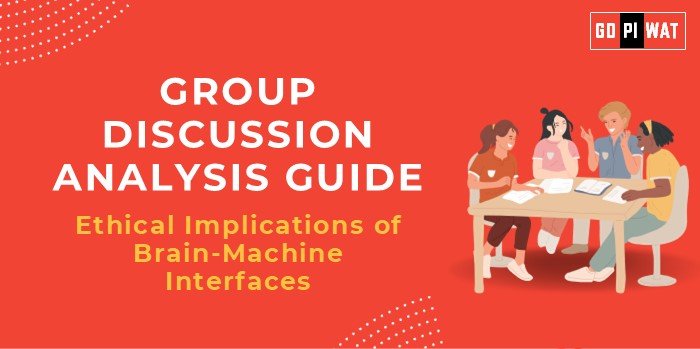📋 GD Analysis Guide: Ethical Implications of Brain-Machine Interfaces
🌐 Introduction to the Topic
- Opening Context: Brain-Machine Interfaces (BMIs), once the stuff of science fiction, are rapidly becoming a reality. From enabling the paralyzed to regain mobility to creating direct thought-to-machine connections, BMIs represent a profound technological frontier.
- Topic Background: The development of BMIs began with medical applications like cochlear implants and has now expanded into brain-computer interfaces for gaming, education, and military use. Recent breakthroughs from companies like Neuralink and academic institutions highlight the potential and challenges of integrating human cognition with machines.
📊 Quick Facts and Key Statistics
- Global BMI Market Size: Estimated at USD 2.0 billion in 2023, projected to grow at a CAGR of 17.8% from 2024 to 2030.
- Medical Applications: BMIs are being developed to assist individuals with neurological conditions, such as amyotrophic lateral sclerosis (ALS) and spinal cord injuries, by restoring communication and mobility.
- Privacy Concerns: The integration of BMIs raises ethical questions about the potential for misuse of neural data, highlighting the need for robust data protection measures.
- Military Interest: Defense agencies are exploring BMIs for applications like enhanced communication and control systems, which introduces additional ethical considerations regarding their use in warfare.
🤝 Stakeholders and Their Roles
- Researchers and Developers: Universities and tech companies are at the forefront of BMI innovation, focusing on both medical and non-medical applications.
- Governments and Regulatory Bodies: Responsible for establishing ethical guidelines, approving clinical trials, and ensuring the safe deployment of BMI technologies.
- Healthcare Providers: Implement BMIs in clinical settings to improve patient outcomes, particularly for those with severe neurological impairments.
- Patients and the General Public: Beneficiaries of BMI advancements, whose concerns about privacy, autonomy, and ethical use must be addressed.
🏆 Achievements and Challenges
Achievements:
- Medical Breakthroughs: BMIs have enabled individuals with paralysis to control prosthetic limbs and communicate through computer interfaces.
- Technological Advancements: Significant progress in non-invasive BMI techniques has expanded their potential applications.
Challenges:
- Ethical Dilemmas: Issues such as consent, privacy, and the potential for cognitive manipulation are central ethical concerns.
- Accessibility and Equity: High costs and technological complexity may limit access, potentially exacerbating social inequalities.
- Security Risks: The possibility of hacking or unauthorized access to neural data poses significant threats.
🌍 Global Comparisons
- Success Example: Countries with robust data protection laws, like those in the European Union, are better positioned to address ethical concerns related to BMIs.
- Challenges Example: Regions with less regulatory oversight may face difficulties in managing the ethical implications of rapid BMI adoption.
🛠️ Structured Arguments for Discussion
- Supporting Stance: “BMIs offer unprecedented opportunities for medical rehabilitation and human enhancement, justifying their development and integration into healthcare.”
- Opposing Stance: “The ethical risks associated with BMIs, including potential breaches of privacy and autonomy, outweigh the benefits, necessitating caution in their deployment.”
- Balanced Perspective: “While BMIs present significant advantages, it is imperative to develop comprehensive ethical frameworks to mitigate associated risks.”
🚀 Effective Discussion Approaches
- Opening Approaches:
- Statistic-Driven: “With the BMI market projected to reach USD 5.4 billion by 2032, the ethical implications of such rapid growth demand our attention.”
- Philosophical Opening: “As we bridge the gap between mind and machine, we must consider: at what cost to our humanity?”
- Counter-Argument Handling:
- Highlight existing ethical guidelines and propose enhancements to address emerging concerns.
- Emphasize the potential for BMIs to improve quality of life, advocating for balanced risk management.
📈 Strategic Analysis of Strengths and Weaknesses
- Strengths: Potential to revolutionize medical treatments for neurological disorders, advancement of human-computer interaction technologies.
- Weaknesses: High development and implementation costs, limited public understanding and acceptance.
- Opportunities: Development of international ethical standards and regulations, expansion into diverse fields such as education and communication.
- Threats: Potential misuse by authoritarian regimes or malicious entities, public backlash due to ethical concerns leading to restrictive regulations.
🎓 Connecting with B-School Applications
- Real-World Applications: Leadership in developing ethical guidelines for emerging technologies, strategic management of tech innovations in healthcare and beyond.
- Sample Interview Questions:
- “How would you address the ethical challenges posed by BMIs in a corporate setting?”
- “What strategies would you implement to ensure equitable access to BMI technologies?”
- Insights for B-School Students: Understanding the intersection of technology, ethics, and business is crucial for future leaders, engaging with emerging technologies like BMIs offers opportunities to shape their ethical integration into society.


